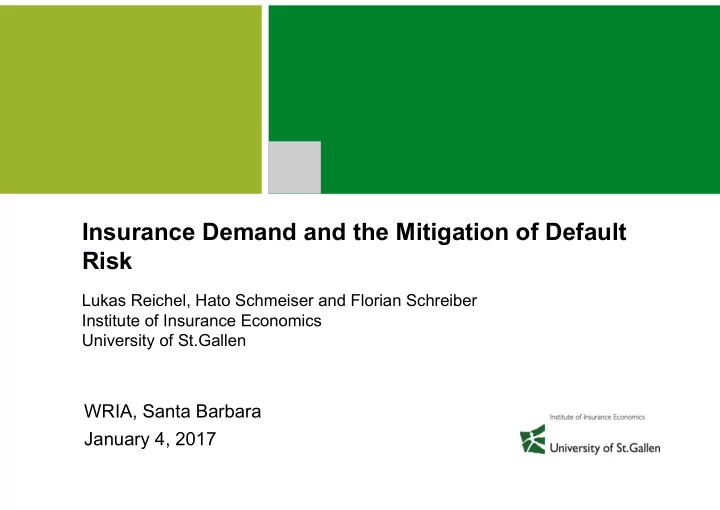

Insurance Demand and the Mitigation of Default Risk Lukas Reichel, Hato Schmeiser and Florian Schreiber Institute of Insurance Economics University of St.Gallen WRIA, Santa Barbara January 4, 2017
Mossin’s Demand Model as Starting Point 2 Mossin, J. (1968) . Aspects of Rational Insurance Purchasing. Journal of Political Economy, 76, 533-568 Full coverage is optimal iff premium is actuarially fair Lukas Reichel WRIA, Santa Barbara January 4, 2017
Mossin’s Demand Model as Starting Point 3 Mossin (1968) (default-free setting) �, � � � 0, Lukas Reichel WRIA, Santa Barbara January 4, 2017
Modified Demand Model: The Case of Non-Performance 4 Mossin (1968) (default-free setting) �, � � � 0, Doherty N., Schlesinger H. (1990) . Rational Insurance Purchasing: Consideration of Contract Nonperformance. Quarterly Journal of Economics, 105, 243-253 Given default risk, over- or under-insurance may be optimal even though the premium is actuarially fair Lukas Reichel WRIA, Santa Barbara January 4, 2017
Modified Demand Model: The Case of Non-Performance 5 Mossin (1968) (default-free setting) �, � � � 0, Doherty & Schlesinger (1990) 1, � � � � � 0, Lukas Reichel WRIA, Santa Barbara January 4, 2017
Modified Demand Model: The Case of Non-Performance 6 Mossin (1968) (default-free setting) �, � � � 0, Doherty & Schlesinger (1990) 1, � � � � � 0, Mahul O., Wright B. D. (2007) . Optimal Coverage for Incompletely Reliable Insurance, Economic Letters 95, 456-461 Optimality of under- or over-insurance depends on size of recovery rate Lukas Reichel WRIA, Santa Barbara January 4, 2017
Modified Demand Model: The Case of Non-Performance 7 Mossin (1968) (default-free setting) �, � � � 0, Doherty & Schlesinger (1990) 1, � � � � � 0, Mahul O., Wright B. D. (2007) . Optimal Coverage for Incompletely Reliable Insurance, Economic Letters 95, 456-461 Optimality of under- or over-insurance depends on size of recovery rate Optimal insurance demand under the risk of contract nonperformance, if default risk can be mitigated? explicit risk-management measure; diversification Lukas Reichel WRIA, Santa Barbara January 4, 2017
Our Model Framework 8 Mossin (1968) (default-free setting) �, � � � 0, Doherty & Schlesinger (1990) 1, � � � � � 0, Our model framework � co-insurers: each co-insurer holds � in premium and losses � and � are � � � � � � � our decision variables • is the random number of failed insurers ��� ��� • is the joint default correlation factor � � • = 0 has a binomial distribution (independent defaults) Lukas Reichel WRIA, Santa Barbara January 4, 2017
Our Model Framework: The Premium & Fee Principle 9 Assumed premium/fee principle: Expected Payoffs x Proportional Cost Loading Premium for insurance coverage: � � � Independent � � of and ! � � � � � Each insurer receives as becomes large: fixed running costs? � � � Fee for risk-management measure: � � � Independent of and ! � � � � � � Lukas Reichel WRIA, Santa Barbara January 4, 2017
Question I: Price Effects on Insurance-Demand-Curve 10 Researching price effects Insurance-demand- Insurance-demand- curve is shifted to curve is shifted to What happens to the the left the right optimal insurance ∗ if the coverage � costs for hedging increase ( � ? Is insurance coverage a substitute or complement of the risk-management measure? Insurance coverage as substitute Insurance coverage as complement Lukas Reichel WRIA, Santa Barbara January 4, 2017
Question II: Effect of Diversification 11 • Assumed the insurer can increase the number of co-insurers from n to n+1 Natural question: Is it optimal to increase or to decrease insurance coverage ? • First intuition: Given two policies, it seems to be nearby that it is optimal to take up more of the policy that provides higher utility. Lukas Reichel WRIA, Santa Barbara January 4, 2017
Question II: Effect of Diversification 12 • Assumed the insurer can increase the number of co-insurers from n to n+1 Natural question: Is it optimal to increase or to decrease insurance coverage ? • First intuition: Given two policies, it seems to be nearby that it is optimal to take up more of the policy that provides higher utility. But: Numeric Example: Initial wealth 1.5 Loss prob. p 5.0 % Loss size l 1.0 Default prob. q 1.0 % Correlation 15 % Cost loading 0.0 � Lukas Reichel WRIA, Santa Barbara January 4, 2017
Monotonicity Criterion 13 ∗ Let be the optimal insurance demand for co-insurers and set �,� ∗ ∗ ∗ ∗ � �,� �,� �,� ∗ holds true, if ∗ Then, �,��� �,� ��� ∗ for all � ∗ � � � ��� �� where is the policyholder’s measure of relative prudence. ∗ (1) For quadratic utility strictly increases in (always) �,� ��� ∗ (2) For power utility , with ), strictly increases, if �,� ∗ (i.e. over-insurance (3) If policyholder has constant absolute prudence and if � is optimal for , Mahul & Wright, 2007), then: ∗ decreasing (increasing) coverage is optimal �,� Lukas Reichel WRIA, Santa Barbara January 4, 2017
Monotonicity Criterion: Influence of Prudence 14 • Assumed the insurer can increase the number of co-insurers from n to n+1 Natural question: Is it optimal to increase or to decrease insurance coverage ? • First intuition: Given two policies, it seems to be nearby that it is optimal to take up more of the policy that provides higher utility. Numeric Example: High prudence High degree of over-insurance Initial wealth 1.5 Loss prob. p 5.0 % Loss size l 1.0 Low prudence Default prob. q 1.0 % Less over- insurance Correlation 15 % Cost loading 0.0 � Lukas Reichel WRIA, Santa Barbara January 4, 2017
Thank You 15 Lukas Reichel Institute of Insurance Economics University of St. Gallen Tannenstrasse 19 9000 St. Gallen Switzerland lukas.reichel@unisg.ch Lukas Reichel WRIA, Santa Barbara January 4, 2017
Recommend
More recommend